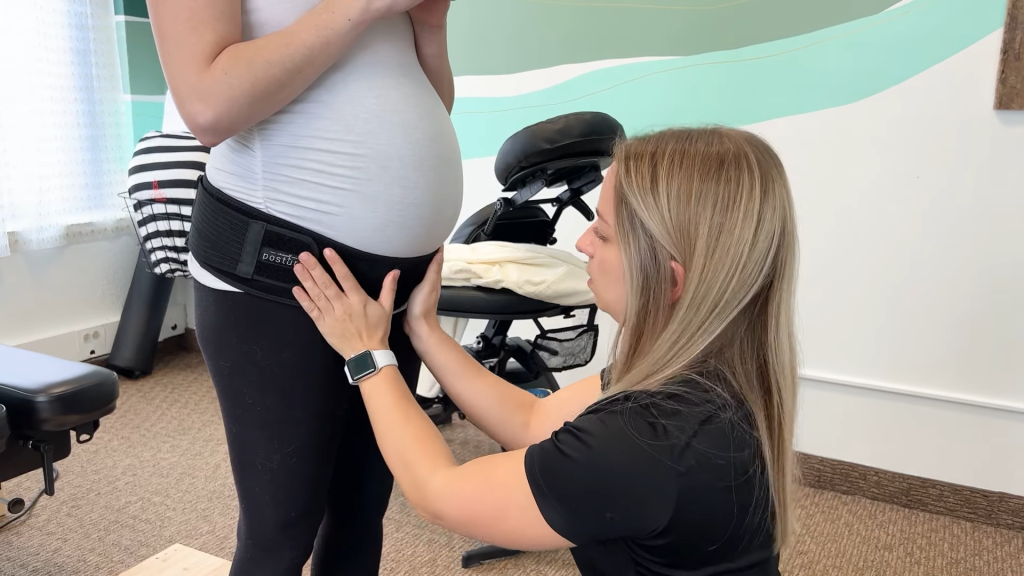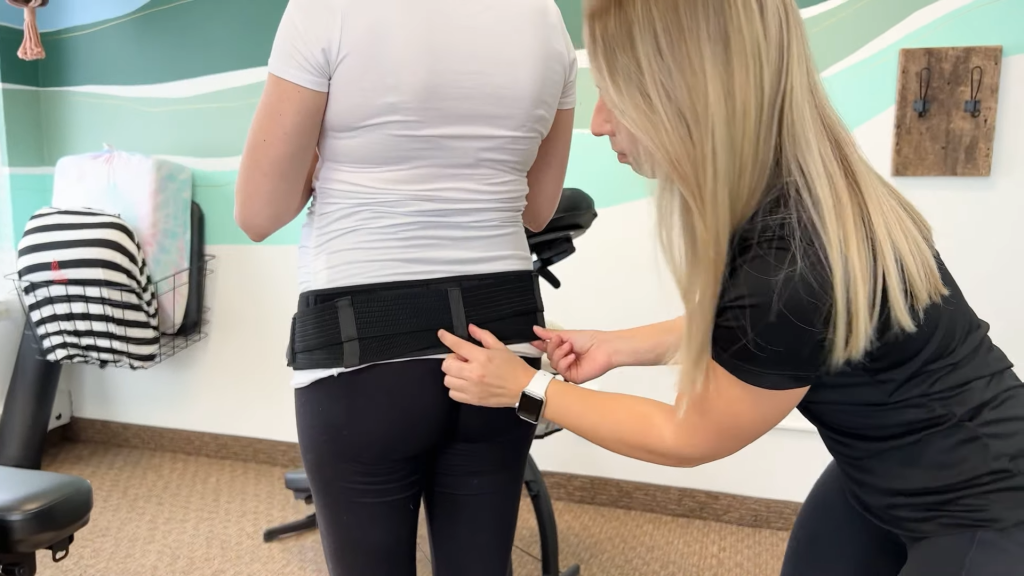Discover the potential benefits of wearing a postpartum support belt or girdle in managing back pain after childbirth.
Can Wearing a Postpartum Support Belt or Girdle Help Manage Back Pain?
Congratulations, mama! You’ve just welcomed your bundle of joy into the world. But along with the bliss of motherhood, you might be experiencing some not-so-blissful postpartum back pain. Don’t worry, though – we’ve got your back (literally!). In this article, we’ll explore the world of postpartum support belts and girdles and uncover whether they can help manage that pesky back pain. So, let’s dive right in, shall we?

Understanding Postpartum Back Pain
Ah, postpartum back pain – the not-so-pleasant reminder that your body has just gone through a tremendous journey. But what causes this discomfort, you ask? Well, there are several factors at play here.
First and foremost, your body has undergone significant changes during pregnancy, including hormonal shifts and the stretching of ligaments and muscles to accommodate your growing baby. Once your little one is out in the world, your body needs time to readjust, and this can lead to some discomfort, especially in the back.
On top of that, the sleepless nights, constant baby-carrying, and endless diaper changes can take a toll on your posture, leading to added strain on your back muscles. And let’s not forget about those breastfeeding sessions – hunching over to feed your baby can cause tension in your back as well.
But what about the duration of postpartum back pain? Now, you might be wondering: “How long do I have to endure this back pain?” Well, the good news is that postpartum back pain is usually temporary and tends to dissipate within a few weeks or months as your body continues to heal. However, for some mamas, the discomfort can linger for a bit longer.
So, let’s explore whether support belts and girdles can come to the rescue! These postpartum support tools are designed to provide gentle compression and support to your abdominal and back muscles, helping to alleviate some of the discomfort you may be experiencing. They can also help improve your posture by providing stability to your core, reducing the strain on your back.
When choosing a support belt or girdle, it’s important to find one that fits well and offers the right level of support for your specific needs. Some are adjustable, allowing you to customize the fit as your body continues to change during the postpartum period.
Aside from support belts and girdles, there are other measures you can take to manage postpartum back pain. Gentle exercises, such as pelvic tilts and gentle stretches, can help strengthen your core and alleviate some of the discomfort. It’s important to consult with your healthcare provider before starting any exercise routine to ensure it’s safe for you.
In addition to exercises, heat therapy, such as warm compresses or heating pads, can provide temporary relief by increasing blood flow to the affected area and relaxing tense muscles. Taking breaks throughout the day to rest and elevate your feet can also help alleviate some of the strain on your back.
Remember, postpartum back pain is a common experience for many new moms, and while it can be uncomfortable, it is usually temporary. With time, rest, and the right support, you’ll be back on your feet and enjoying the joys of motherhood without the added discomfort.
The Role of Postpartum Support Belts and Girdles
Enter postpartum support belts and girdles – the trusty sidekicks that promise some much-needed relief. But what exactly are they, and how do they work their magic?
After giving birth, many women experience discomfort and pain in their abdominal and lower back muscles. This can make it challenging to perform daily activities and care for their newborns. That’s where postpartum support belts and girdles come in.
The Design and Purpose of Support Belts
Support belts are typically made from elastic material and are designed to wrap around your abdomen, providing gentle compression and support to your abdominal and lower back muscles. They aim to offer stability and reduce the strain on your back, helping you get back on your feet (literally!) faster.
These belts are adjustable, allowing you to customize the level of compression based on your comfort and needs. They are also discreet and can be worn under your clothing, providing support without drawing attention.
Support belts not only help with pain relief but also promote proper posture. After pregnancy, your abdominal muscles may be weakened, and your posture may suffer as a result. By supporting your core, these belts encourage you to maintain good posture, which can prevent further strain on your back.
Additionally, support belts can aid in the recovery of abdominal muscles. During pregnancy, the abdominal muscles stretch to accommodate the growing baby. After childbirth, these muscles need time to regain their strength and elasticity. Support belts provide gentle compression, helping the muscles come back together and heal properly.
How Girdles Provide Support
Girdles, on the other hand, are like a superhero suit for your postpartum body. These snug garments offer firm compression and support to your entire midsection, including your abdomen, hips, and back. By hugging your curves, girdles help redistribute the weight and relieve the pressure on your lower back.
One of the main advantages of girdles is their ability to provide a slimming effect. After giving birth, many women may feel self-conscious about their post-baby bodies. Girdles can help smooth out any lumps or bumps, giving you a more streamlined appearance and boosting your confidence.
Furthermore, girdles can also assist in the healing process after a C-section. The compression they provide can help reduce swelling and promote proper incision healing. By supporting the abdominal muscles and reducing strain on the incision site, girdles can aid in a quicker and more comfortable recovery.
It’s important to note that while postpartum support belts and girdles can be beneficial, they should be used in consultation with your healthcare provider. Every woman’s postpartum journey is unique, and it’s essential to ensure that these garments are suitable for your specific needs and recovery process.
The Connection Between Support Belts, Girdles, and Back Pain
Now that we understand how these support garments are designed to help, let’s delve into how they specifically tackle postpartum back pain.
Postpartum back pain is a common issue that many new mothers experience. The physical changes that occur during pregnancy, such as weight gain and hormonal shifts, can put a strain on the back muscles and ligaments. This strain, combined with the weakened abdominal muscles after childbirth, can lead to discomfort and pain in the lower back.

How Support Belts Alleviate Back Pain
Support belts work their magic by providing extra support to your weakened abdominal muscles. By wrapping around your waist and lower back, these belts help improve your posture and reduce the strain on your back. The added support not only offers relief from that nagging discomfort but also promotes proper alignment of the spine.
But that’s not all! Support belts also provide gentle compression to the abdominal area. This compression gives your muscles a reassuring hug, helping to ease any tension and promote healing. The increased blood flow to the area can also aid in reducing inflammation and speeding up the recovery process.
The Effectiveness of Girdles in Pain Management
Girdles take things up a notch by offering more comprehensive support. Their firm compression not only helps with back pain but can also provide stability to your hips and pelvis, which may have become misaligned during pregnancy.
During pregnancy, the ligaments in the pelvic area loosen to prepare for childbirth. This can lead to misalignment of the hips and pelvis, causing additional strain on the back. Girdles help support your body’s natural realignment process by providing firm compression to the pelvic area. By stabilizing the hips and pelvis, girdles can alleviate discomfort and promote a faster recovery.
Furthermore, girdles can also provide support to the abdominal muscles, similar to support belts. This added support helps improve posture, reduce strain on the back, and promote proper alignment of the spine. By addressing multiple areas of concern, girdles offer a comprehensive solution for postpartum back pain.
In conclusion, both support belts and girdles are effective tools in managing postpartum back pain. They provide support to the weakened abdominal muscles, improve posture, reduce strain on the back, and promote proper alignment of the spine. Whether you choose a support belt or a girdle, these garments can offer relief from discomfort and aid in the recovery process after childbirth.
Considerations Before Using Support Belts and Girdles
While support belts and girdles can be a game-changer for many mamas, there are a few things to keep in mind before jumping on the bandwagon.
Support belts and girdles have gained popularity among postpartum women for their ability to provide much-needed support and comfort during the recovery period. However, it is important to approach their usage with caution and consider a few key factors.
Safety Measures and Precautions
Before using any postpartum support garment, it’s crucial to consult with your healthcare provider. They can evaluate your specific situation and ensure that the use of a support belt or girdle is safe and appropriate for you. Your healthcare provider will take into account factors such as the type of delivery you had, any complications you may have experienced, and the overall condition of your body postpartum.
Additionally, it is important to be aware of any potential risks associated with wearing support belts and girdles for extended periods. While these garments can provide much-needed support, wearing them excessively or too tightly may lead to discomfort or even restrict blood flow. It is essential to strike a balance and allow your body some breathing room to avoid any potential issues.
Choosing the Right Fit and Material
When selecting a support belt or girdle, aim for a snug, but not overly tight fit. Comfort is key! The garment should provide enough support without causing any discomfort or constriction. It is advisable to try on different sizes and styles to find the one that suits you best.
In addition to the fit, pay attention to the material of the support belt or girdle. Look for high-quality, breathable materials that won’t cause irritation or discomfort, especially if you have sensitive skin. Opt for fabrics that allow proper air circulation and moisture-wicking properties to keep you cool and dry throughout the day.
Furthermore, it is important to follow the manufacturer’s guidelines for proper usage and care. Each support belt or girdle may have specific instructions on how long it should be worn daily and how to clean and maintain it. Adhering to these guidelines will ensure that you get the most out of your support garment and prolong its lifespan.
Other Methods to Manage Postpartum Back Pain
While support belts and girdles can be a game-changer for many mamas, they’re not the only solution in the arsenal against postpartum back pain. Here are a few alternative methods you can explore:
Physical Therapy and Exercise
Engaging in gentle exercises and physical therapy can help strengthen your back and core muscles, promoting a faster recovery. Your healthcare provider or a specialized postpartum physical therapist can guide you through safe and effective exercises tailored to your needs.
Medication and Natural Remedies
In some cases, your healthcare provider might recommend medication or natural remedies to manage your postpartum back pain. Always consult with them before taking any medication or trying new remedies, and remember that every mama’s journey is unique.
So, there you have it – everything you need to know about postpartum support belts and girdles and their potential role in managing back pain. While they can offer much-needed support and relief, remember to listen to your body and consult with your healthcare provider before starting any new postpartum routine. After all, you deserve to enjoy this beautiful new chapter of motherhood without unnecessary discomfort. Take care, mama – you’ve got this!



